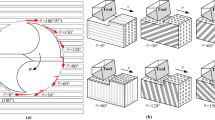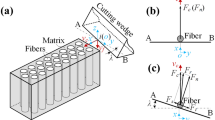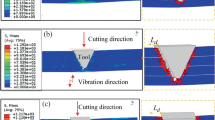Abstract
The shear cutting in the thickness direction is suitable for trimming of sheets due to its short cycle time. Development of short-cycle manufacturing techniques for carbon fiber–reinforced thermoplastics (CFRTP) is highly demanded; however, the practical use and the study of the shear cutting are limited; thus, the knowledge of its mechanism and process parameters is limited. This study experimentally investigated the deformation behavior during shear cutting and the effect of process parameters on the cut-end profile. From the shearing stress curve and the high-speed video image, we found the bending phase, the shearing phase, and the fracturing phase in the cutting process. It was assumed that the transition from the shear to the fracturing occurred when the tensile stress act in the surface layer of the residual thickness exceeds the tensile strength of the fiber layer. The clearance influenced on the inclination of the sheared face; however, it did not affect the areal fraction of the sheared face in the cut-end. The tool with a small edge angle increased the area of the sheared face. The shallow angle between the fibers and the tool led to the uncut fibers. The cutting speed did not affect the cutting behavior and the cut-end profile. These results indicated that the tool design is the dominant factor to control the cutting behavior. These findings provide insight into our understanding of the shear cutting mechanism as well as the development of the optimum tool design.




















Similar content being viewed by others
References
Koplev A, Lystrup A, Vorm T (1983) The cutting process, chips, and cutting forces in machining CFRP. Composites 14(4):371–376. https://doi.org/10.1016/0010-4361(83)90157-X
Li H, Qin X, He G, Jin Y, Sun D, Price M (2016) Investigation of chip formation and fracture toughness in orthogonal cutting of UD-CFRP. Int J Adv Manuf Technol 82:1079–1088. https://doi.org/10.1007/s00170-015-7471-x
Wang DH, Ramulu M, Arola D (1995) Orthogonal cutting mechanisms of graphite/epoxy composite. Part I: unidirectional laminate. Int J Mach Tools Manuf 35(12):1623–1638. https://doi.org/10.1016/0890-6955(95)00014-O
Wang DH, Ramulu M, Arola D (1995) Orthogonal cutting mechanisms of graphite/epoxy composite. Part II: multi-directional laminate. Int J Mach Tools Manuf 35(12):1639–1648. https://doi.org/10.1016/0890-6955(95)00015-P
Wang XM, Zhang LC (2003) An experimental investigation into the orthogonal cutting of unidirectional fibre reinforced plastics. Int J Mach Tools Manuf 43(10):1015–1022. https://doi.org/10.1016/S0890-6955(03)00090-7
Caprino G, Santo L, Nele L (1998) Interpretation of size effect in orthogonal machining of composite materials. Part I: unidirectional glass-fibre-reinforced plastics. Compos A: Appl Sci Manuf 29(8):887–892. https://doi.org/10.1016/S1359-835X(98)00028-1
Liu K, Piggott MR (1995) Shear strength of polymers and fibre composites: 1. thermoplastic and thermoset polymers. Composites 26(12):829–840. https://doi.org/10.1016/0010-4361(95)90876-2
Hocheng H, Tsao CC (2005) The path towards delamination-free drilling of composite materials. J Mater Process Technol 167(2–3):251–264. https://doi.org/10.1016/J.JMATPROTEC.2005.06.039
Hocheng H, Tsao CC (2006) Effects of special drill bits on drilling-induced delamination of composite materials. Int J Mach Tools Manuf 46(12–13):1403–1416. https://doi.org/10.1016/J.IJMACHTOOLS.2005.10.004
Arul S, Vijayaraghavan L, Malhotra SK, Krishnamurthy R (2006) The effect of vibratory drilling on hole quality in polymeric composites. Int J Mach Tools Manuf 46(3–4):252–259. https://doi.org/10.1016/J.IJMACHTOOLS.2005.05.023
Shanmugam DK, Masood SH (2009) An investigation on kerf characteristics in abrasive waterjet cutting of layered composites. J Mater Process Technol 209(8):3887–3893. https://doi.org/10.1016/J.JMATPROTEC.2008.09.001
Shanmugam DK, Chen FL, Siores E, Brandt M (2002) Comparative study of jetting machining technologies over laser machining technology for cutting composite materials. Compos Struct 57(1):289–296. https://doi.org/10.1016/S0263-8223(02)00096-X
Li ZL, Zheng HY, Lim GC, Chu PL, Li L (2010) Study on UV laser machining quality of carbon fibre reinforced composites. Compos A: Appl Sci Manuf 41(10):1403–1408. https://doi.org/10.1016/J.COMPOSITESA.2010.05.017
Herzog D, Jaeschke P, Meier O, Haferkamp H (2008) Investigations on the thermal effect caused by laser cutting with respect to static strength of CFRP. Int J Mach Tools Manuf 48(12–13):1464–1473. https://doi.org/10.1016/j.ijmachtools.2008.04.007
Herzog D, Schmidt-Lehr M, Oberlander M, Canisius M, Radek M, Emmelmann C (2016) Laser cutting of carbon fibre reinforced plastics of high thickness. Mater Des 92:742–749. https://doi.org/10.1016/j.matdes.2015.12.056
Haddad M, Zitoune R, Bougherara H, Eyma F, Castanié B (2014) Study of trimming damages of CFRP structures in function of the machining processes and their impact on the mechanical behavior. Compos Part B 57:136–143. https://doi.org/10.1016/J.COMPOSITESB.2013.09.051
Formisano A, Boccarusso L, Durante M, Langella A (2017) Punch tool based out-of-plane shear behaviour of GFRP composites. Compos Struct 163:325–330. https://doi.org/10.1016/J.COMPSTRUCT.2016.12.048
Ogi K, Yashiro S (2015) Effect of temperature and clearacne on shear cutting behaviors in CFRP laminates. Proceedings of 20th International Congress on Composite Materials
Klocke F, Shirobokov A, Kerchnawe S, Wahl M, Mannens R, Feuerhack A, Mattfeld P (2017) Experimental investigation of the hole accuracy, delamination, and cutting force in piercing of carbon fiber reinforced plastics. Procedia CIRP 66:215–220. https://doi.org/10.1016/j.procir.2017.03.297
Watzke J, Schomäcker M, Brosius A (2014) Cryogenic shear cutting of fiber reinforced plastics (FRP). Procedia CIRP 18:80–83. https://doi.org/10.1016/j.procir.2014.06.111
Yashiro S, Ono R, Ogi K (2019) Effect of machining conditions on the trimming damage in composite laminates induced by out-of-plane shearing. J Mater Process Technol 271:463–475
Acknowledgments
The authors are grateful for the contributions of Mr. Hikaru Tamura and Mr. Amirul Azri Bin Abd Jamal towards this study.
Author information
Authors and Affiliations
Corresponding author
Ethics declarations
Conflict of interest
The authors declare that they have no conflict of interest.
Additional information
Publisher’s note
Springer Nature remains neutral with regard to jurisdictional claims in published maps and institutional affiliations.
Rights and permissions
About this article
Cite this article
Tatsuno, D., Yoneyama, T. & Ibuki, M. Effect of process parameters of shear cutting for carbon fiber–reinforced thermoplastic laminate. Int J Adv Manuf Technol 110, 1125–1138 (2020). https://doi.org/10.1007/s00170-020-05878-7
Received:
Accepted:
Published:
Issue Date:
DOI: https://doi.org/10.1007/s00170-020-05878-7




